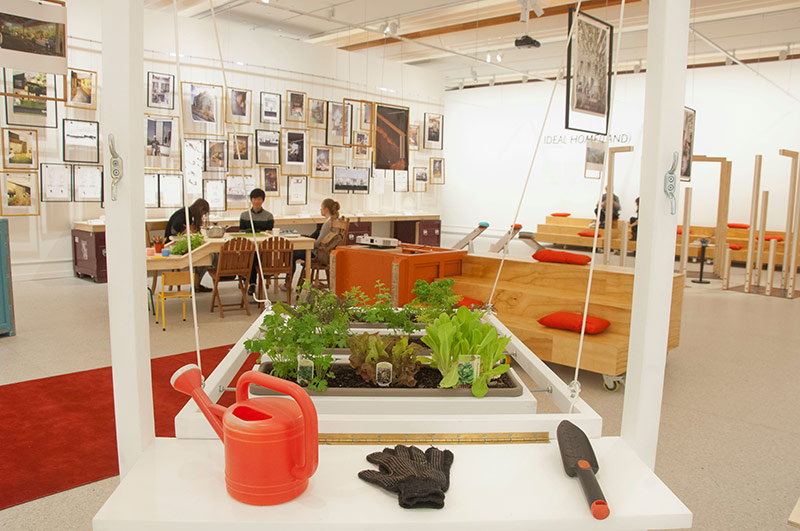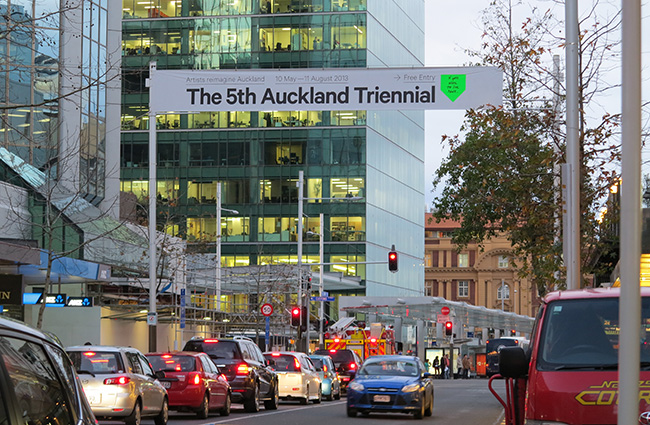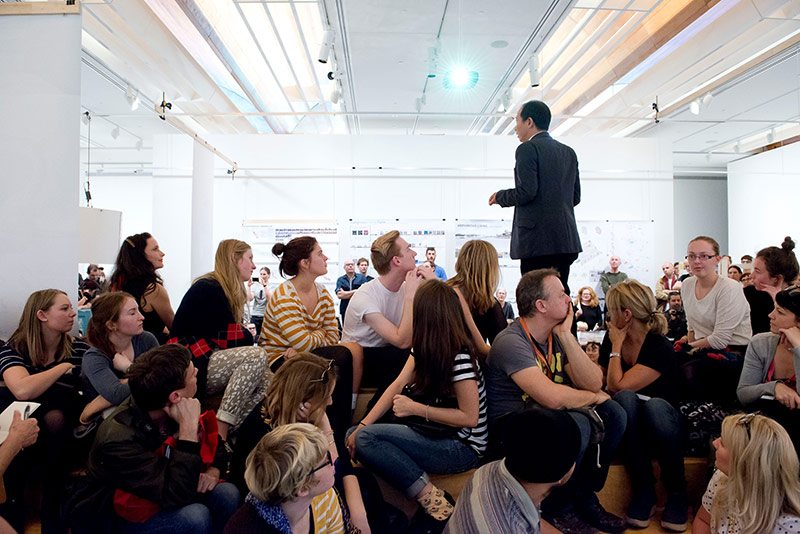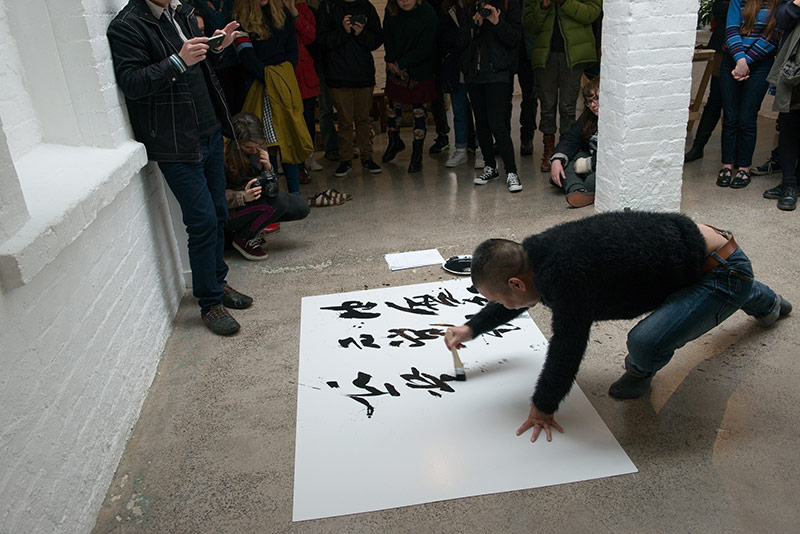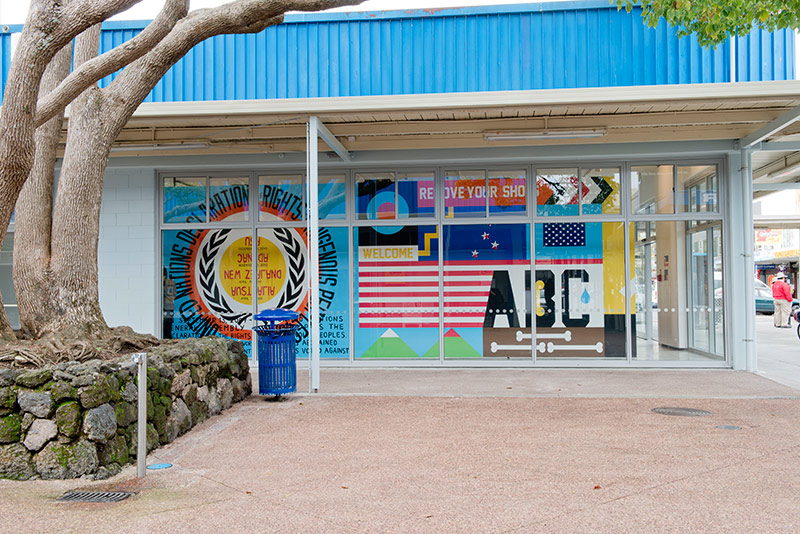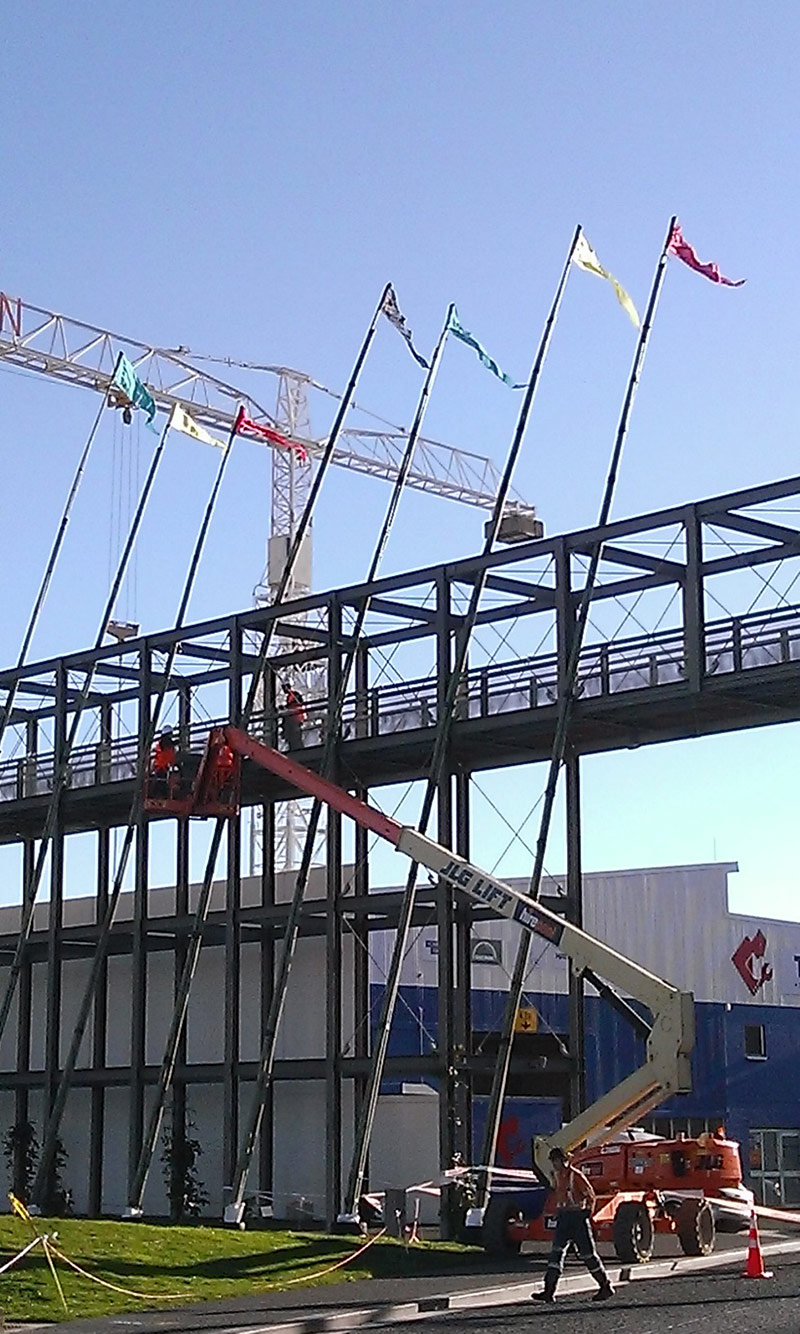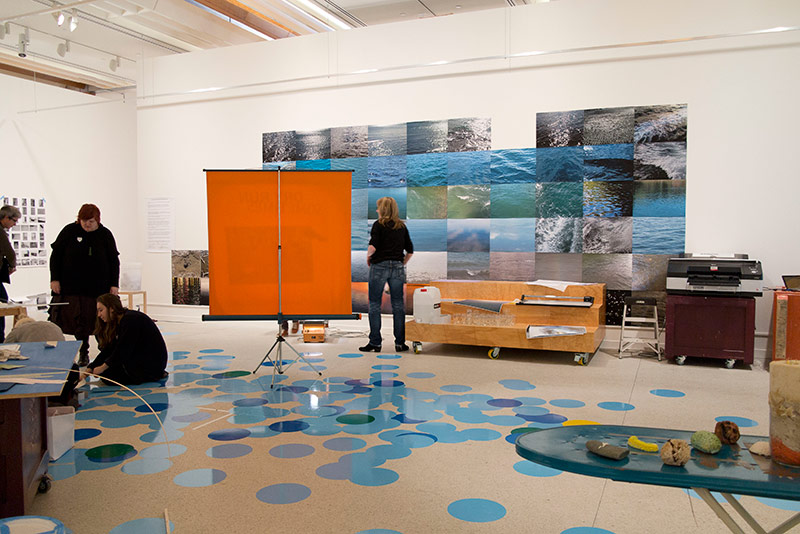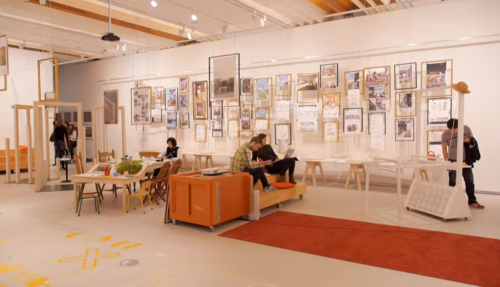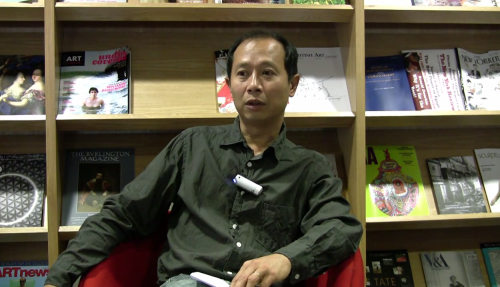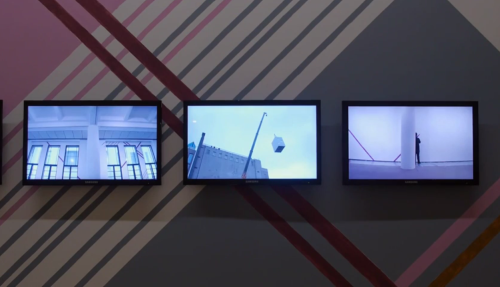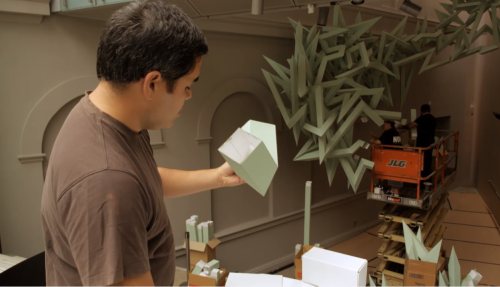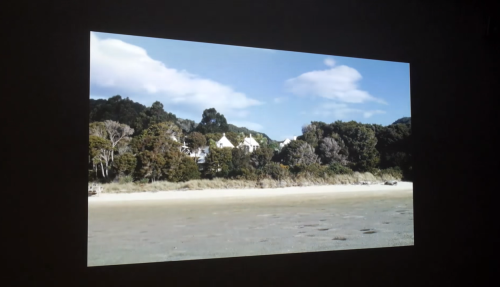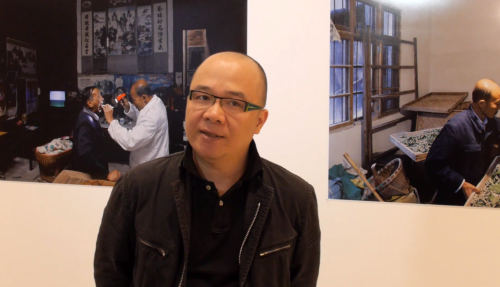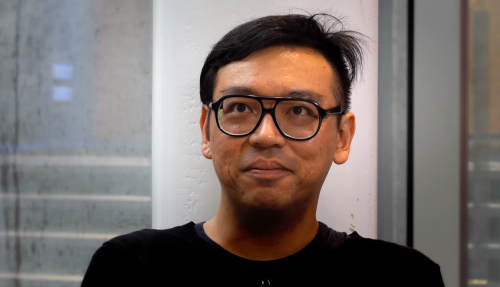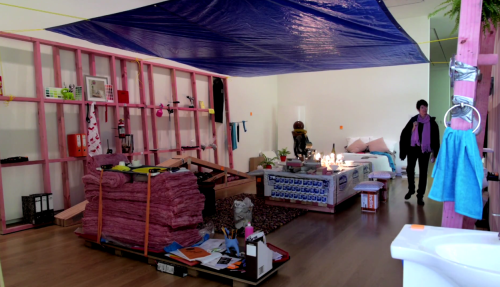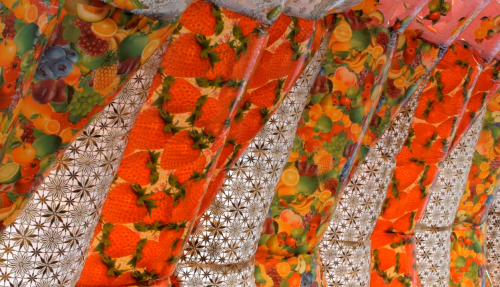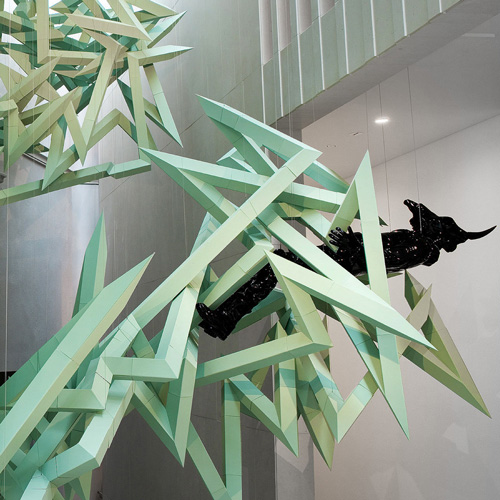—
event Details
Venues
Theme
Artists
The Lab project
Publications
Key events
Archives
Supporters
Curator: Hou Hanru, Director of Exhibitions and Public Programs and Chair of Exhibition and Museum Studies, San Francisco Art Institute. Previously curator of major biennials including Lyon, Istanbul, and Guangzhou.
The 5th Triennial was more ambitious in content and scale than previous Triennials to reflect the prominence of the new Auckland Art Gallery building and also Auckland's status as a 'super city'. This included an international search for the 5th Triennial curator and decision to offer the exhibition free at all venues.
If you were to live here... intended to provoke and promote discussion on urban transformation and cause interaction amongst artists, the people and the city. Hou Hanru invited a diverse range of artists, architects, designers, academics and others to work collaboratively and exploratively to create an event and experience in which diverse, possible and utopian projects of locality making and renovating were presented, tested and achieved.
Forty-six artists participated from 15 countries - Australia, Brazil, China, France, India, Japan, South Korea, Mexico, Morocco, New Zealand, Pakistan, Puerto Rico, Singapore, Taiwan, United States of America.
Visit the 5th Auckland Triennial website for more information
Venues
Presented by the Auckland Art Gallery Toi o Tāmaki and showing across the city at the Artspace, Auckland Museum, Fresh Gallery Otara, George Fraser Gallery, Gus Fisher Gallery, Film Archive, ST PAUL St, Silo6 at Silo Park.
Theme
Curator Hou Hanru described the theme: 'If you were to live here... is a trigger or starting point for participants to work to or challenge'. They offered 'a utopian perspective that emphasises changing existing conditions. To live here does not only mean to dwell here, but to play a role in the reinvention of "here".
'Inviting artists and contributors to imagine and answer the intriguingly complex question, "If you were to live here …" the Triennial promotes debate about a basic but often ignored issue: the vocation of artistic production today in a world oscillating between crisis and opportunity. This will eventually contribute to revitalise urban life itself.'
Artists
Artists in red indicate works that were acquired from the exhibition and form the Auckland Triennial Collection. Artists with aterisks beside their names means that they have works in the Auckland Art Gallery Collection.
- Allora & Calzadilla, United States of America/Puerto Rico
- Yto Barrada, Morocco/France
- Claire Fontaine, France
- Abraham Cruzvillegas, Mexico
- Keg de Souza, Australia
- Emory Douglas, Rigo 23 and Wayne Youle, United States of America/Portugal/New Zealand
- mounir fatmi, Morocco/France
- Claire Healy and Sean Cordeiro, Australia
- Ho Tzu Nyen, Singapore
- Ryoji Ikeda, Japan
- Maddie Leach, New Zealand*
- Janet Lilo, New Zealand*
- Michael Lin and Atelier Bow-Wow, Nanli Lou, Ran Cheng with Andrew Barrie, Taiwan/Japan/China/New Zealand
- Local Time, New Zealand
- Makeshift (Tessa Zettel and Karl Khoe), Australia
- Cinthia Marcelle, Brazil
- Angelica Mesiti, Australia
- Tahi Moore, New Zealand*
- Ou Ning, China
- Peter Robinson, New Zealand*
- Anri Sala, Albania/France
- Allan Sekula/Noël Burch, United States of America
- Bruno Serralongue, France
- Amie Siegel, United States of America
- Shahzia Sikander, Pakistan/United States of America
- Do Ho Suh, South Korea
- Saffronn Te Ratana, Ngataiharuru Taepa, Hemi Macgregor, Ngāi Tūhoe/Te Arawa, Te Āti Awa/Ngāti Rakaipaaka, Ngāti Kahungunu, Ngāi Tūhoe/New Zealand*
- Luke Willis Thompson, New Zealand
- Yangjiang Group (Zheng Guogu, Chen Zaiyan and Sun Qinglin), China
- Zhou Tao, China
The Lab project
The Lab was a joint project between the architecture and spatial design faculties of AUT University, The University of Auckland and UNITEC. Working alongside students, local academics, designers and architects developed a series of two to three week-long interdisciplinary design projects.
Project 1: Muddy Urbanism
Project Leaders: Kathy Waghorn, artist, designer and lecturer, School of Architecture and Planning, The University of Auckland. Teddy Cruz, Professor, Public Culture and Urbanism in the Visual Arts Department at the University of California, San Diego; co-founder, Center for Urban Ecologies. Esther Mecredy (Teaching Assistant) and Nina Patel (Researcher).
University of Auckland Postgraduate Architecture Studio team: Herman Haringa, Raimana Jones, Chia Venn Khoo (KCV), Sophia Whoi Seung Kim, Antonia Lapwood, Zee Shake Lee, Steven Lin, Vinni Paget, Hannah Ryan, Angela Yoo.
Kathy Waghorn with Teddy Cruz and the Architecture Studio Team created proposals for the rejuvenation of the Whau River area in Avondale. Muddy Urbanism, a post-graduate urban-research workshop commenced by producing a series of critical mappings of the Whau River, which uncovered both the conflicts inherent to this space and the urban potential that might be generated through re-establishing the neighbourhoods' spatial, social and economic relationship to the waterway. From this a series of urban proposals were generated.
9–19 May 2013
Level 2 exhibition spaces, Auckland Art Gallery
Project 2: Ideal Home(land)
Project Leaders: Sarosh Mulla, founding director of OH.NO.SUMO design collective and PhD student at The University of Auckland School of Architecture and Planning with Melanie Pau (Teaching Assistant).
University of Auckland Postgraduate Architecture Studio team: Kelly Chapman, Jiawei Duan, Nasim Faghih, Emma Farmer, Aditi Kumar, Tim Kvingedal, Ting-Hin Lam, Shieun Lee, Woo Min Lee, Kate McBurney, Hannah Steenson, Grace Tolley, An Wei, Huilin Yan.
Sarosh Mulla working with Architecture students, created a specially designed installation exploring the Kiwi 'quarter-acre dream'. The Lab was used as a mechanism for discussing future ideal homes in Auckland. What will the ideal home be like in 15 or 20 years, or even tomorrow? Ideal Home(land) proposed projects for a single site in Ponsonby (an inner-city Victorian suburb in Auckland), catering for a diverse range of client types. While the original home probably accommodated about five people, the end design proposals made aimed to house about 17 residents. With this number including four different groups 'Typical' of the Auckland housing market – a retiring couple, a multi-generational family, a nuclear family and a group of frends who have pooled their resources to buy property together - there were a diverse group of desires and needs that the design proposals needed to cater for.
21 May – 9 June 2013
Level 2 exhibition spaces, Auckland Art Gallery
Project 3: Matariki Paparewa
Project Leaders: Carin Wilson, Lecturer (Architecture) and Rau Hoskins, Lecturer/Māori Studio Director (Architecture) Te Hononga, Centre for Māori Architecture and Appropriate Technologies, Department of Architecture, Faculty of Creative Industries and Business, Unitec Institute of Technology, Auckland.
Te Hononga, Centre for Māori Architecture and Appropriate Technologies Design Studio Team: Juliane Behnert, Samantha Chu, Sirkes Dankha, Jessica Hulme, Jade Kake, Ina Klinkhardt, Breean Morgan, Peter Morgan, John Myburg, Pearl Patel, Akshay Shah, Brent Withers.
Celebrating Tāmaki Treaty Settlements and Iwi Impacts on Urban Transformation. Matariki Paparewa coincided with the rising of the Matariki star cluster (also known as the Pleiades) in June, which marks the beginning of Matariki or Māori New Year.
Matariki Paparewa was a design and construct project by students of Māori Architecture Studies. It drew cues from the historical Hākari stages, a traditional form of Māori celebratory architecture not seen since the mid-1800s, with the last know 400-yard long structure built in Remuera by Tāmaki iwi (tribes) in 1844. Bamboo and textile elements activates and engages with Silo Park's gantry structure to which it was anchored, creating an impressive site-specific sculptural form. Looking towards the future and within the context of a fast-growing multi-ethnic city, this project provided opportunities to further the dialogue around the ways in which the 19 Tāmaki iwi groups reposition themselves in terms of their kaitiaki (stewardship) roles and begin to reassert their identity in the physical environment.
Project 4: Transforming Topographies
Project Leaders: Emily O'Hara, Elvon Young & Albert Refiti (Spatial Design), Monique Redmond, Lars Jerlach & Dieneke Jansen (Visual Arts), AUT University.
Transforming Topographies Project Participants: Louisa Afoa, Tosh Ahkit, Darcell Apelu, Cathy Carter, Fu-On Chung, Alex Clark, Jordan Cocker, Caspar Connolly-Hiatt, Heather Crawcour, Josie Do Nizza, Ekarasa Doblanovic, Megan Doran-Read, Catherine Downs, Nicole Drake, Charlotte Drayton, Sally Duong, Jasmine Duthie, Catherine Ellis, Azadeh Emadi, Philippa Emery, Alexandra Hanna, Gareth Hemmings, Zainab Hikmet, Hannah Hopewell, Jenny Horrell, Huai Hsuan Huang, Sarah Jennings, Max Johnson, Ryder Jones, Claudia Jowitt, Joseph Jowitt, Tinaz Karbhari, Melanie Kassian, Sarah Keeling, Gabrielle Kendall, Michael Kennedy, Chris Kim, Oliver Latimer, Colie Leung, Ziggy Lever, Johnny Liu, Ruby Lloyd, Kelly McDowell, Holli McEntegart, Maggie McMillan, Angela Moir, Colin Nairn, Ammon Ngakuru, Nick O'Rourke, Dominic Paea, Lee Parker, Billie Popovic, Alex Plumb, Joe Prisk, Nadia Rivai, Deborah Rundle, Joshua Rutter, Mark Schroder, Joanne Shyu, Kelsey Stankovich, Harriet Stockman, Mandy Thomsett-Taylor, Debbie Tubb, Layne Waerea, Bradley Walters, Cora-Allan Wickliffe, Rachel Wilcox, Evan Woodruffe, Bill Xie, Jewel Yan, Jay Yong, Nikki Zhao.
A series of events: 21 days/80 participants/34 projects
Transforming Topographies was envisaged as a space of mergence, debate and negotiation. A space continuously dismantled, repositioned and energised by groups and individuals in conversation within a fluid and open state of oscillation. As a group of thinkers, collaborators, makers and designers the intention was to rethink the role of 'the social' and 'the public' as real spaces of continuous exchange and encounter that engendered our imagination and community values. Many of the 34 projects dealt with how it is that we relate to place, to 'being here in New Zealand' – to the society we live in and to political, social, ethical and psychological contexts.
A curatorial strategy, a diagrammatic system was developed for grouping the projects - rocks, mist, firecrackers - designed to create a shifting platform of events and activity within The Lab. Rocks were the large-scale installation/time-based projects that ran for significant lengths of time, Mist were projects that occupied The Lab for short time frames, or merged in and out of the space, and Firecrackers were one-off, one-day or pop-up events/interventions, often performative in nature.
2–21 July 2013
Level 2 exhibition spaces, Auckland Art Gallery
Project 5: Disasters, Fires and Slow-motion Earthquakes
Project Leader: Prof. Andrew Barrie, School of Architecture and Planning, the University of Auckland. Exhibition design and realisation: Melanie Pau
University of Auckland Postgraduate Architecture Studio team: Jeremy Bailey, Tegan Barry, Lesley Chen, Qianzi Chen, Young Kim, Lee Hui Lai, Sidney Leong, Zhengbang Liu, Seungjoo (Samuel) Ryu, Yichen Song, Timothy Stevenson, Jiayin Tang, Muse Tongthamchart, Laury van der Linden, Ning Wei, Yuan Zhang.
Andrew Barrie and his Architecture Studio Team's project for the Auckland Triennial looked to apply his more-with-less approach at an urban scale, addressing the impact of the Christchurch earthquake. Barrie's project looked to put Christchurch's current challenges in the context of the rebuilding of Napier after the 1931 earthquake and subsequent fires, and of the future challenges facing Auckland, where both increased insurance costs and building code changes threaten to cut a swathe through our stock of heritage buildings, creating a slow-motion earthquake that may devastate New Zealand's towns and cities for decades to come.
23 July – 11 August
Level 2 exhibition spaces, Auckland Art Gallery
Publications
The 5th Auckland Triennial catalogue was edited by Hou Hanru. 216 pages. RRP $42
If you were to live here... contained four major essays, by curator Hou Hanru, Christina Barton, Pascal Beausse and Felicity Fenner, followed by sections grouping artists according to venue or project. Commissioned essays for each artist, plus list of works and brief biographies. Introductory essays for five Lab projects.
Full list of artist page contributors: Ali Akay, Andrew Barrie, Christina Barton, Pascal Beausse, Nigel Borell/Ema Tavola, Marcus Boroughs, Danny Butt, Andrew Clifford, Natasha Conland, David Cross, Alex Davidson, Anna Davis, Mike Davis, Luisa Duarte, Felicity Fenner, Beatrice Gralton, Hou Hanru, Honor Harger, Yuko Hasegawa, Hu Fang, Charlotte Huddleston, Echo Janman, Clara Kim, Bill McKay, Vera Mey, Jacqueline Millner, Sarosh Mulla, Jem Noble, Albert Refiti, Caterina Riva, Peter Shand, Yasmeen M Siddiqui, Huhana Smith, Elizabeth Thomas, Luke Willis Thompson, Nina Tonga, Linda Tyler, Kathy Waghorn with Teddy Cruz, Xiaoyu Weng, Carin Wilson and Rau Hoskins, Kaleen Wilson-Goldie.
Additional publications
- Ryoji Ikeda: A [for 6 Silo] a brochure published by Auckland Art Gallery.
- The Lab: If you were to live here... University of Auckland and Auckland Art Gallery, 2014.
- Muddy Urbanism: Generating a Productive Coastline for Auckland. Editor Kathy Waghorn. Distributed by Lulu
- Go Bush: Alternative Life in New Zealand. Editor Ou Ning. Published by V-ECO
- Hou Hanru. Edited by Natalie King and Victoria Lynn. Published by Utopia, University of Melbourne, 2014
- Lab blog sites
Key events
See the 5th Auckland Triennial website for the full list of events
Opening week and international symposia
The keynote speaker for If you were to live here... was curator and art historian, Sarat Maharaj. Most recently chief curator of the Goteborg International Biennial for Contemporary Art, 2011, he has also co-curated the 29th São Paolo Biennial, 2010, and curated the 3rd Guangzhou Biennial, 2008. Maharaj is Professor of Visual Art and Knowledge Systems at Lund University, Sweden and Visiting Professor at Goldsmiths College, London. Maharaj has published several central texts concerning the post-colonial condition of cultural difference and translation.
Teddy Cruz/Estudio Teddy Cruz and Bijoy Jain of Studio Mumbai were both guests of the 5th Auckland Triennial and contributed to discussions on the Lab. Supported by the University of Auckland's School of Architecture and Planning they spoke as part of the Communiqué lecture series.
Pascal Beausse is a curator of Photographic Collections at CNAP, Centre National des Arts Plastiques, Paris. From 2003-06 he was guest curator at Pavilion, Palais de Tokyo, Paris. He is also an art critic and has been a correspondent for Flash Art, and lectures at the Ecole Nationale des Beaux-Arts de Lyon. He contributed to the opening weekend panels and talks.
Pre-opening, Communiqué 2013 Triennial lecture Series, organised by the University of Auckland School of Architecture and Planning, 9 April – 21 May. Speakers included Jonty Valentine (Index) Rachel Shearer, Sarosh Mulla, Teddy Cruz (Estudio Teddy Cruz, San Diego), Bijoy Jain (Studio Mumbai), Mark Davey andNatalie Robertson (Local Time).
May Symposium and panel discussions on 10–12 May.
Ryoji Ikeda test pattern [live set]
Japan's leading electronic composer and visual artist Ryoji Ikeda performed for the first time in New Zealand at the 5th Auckland Triennial. Ikeda's test pattern [live set] is an intense performance of flickering black and white imagery and synchronised stark, staccato sound; all generated in real-time from streams of raw data. The project probes the critical points of device performance and the threshold of human perception, pushing both to their absolute limits.
Saturday 11 May Galatos, 17 Galatos St, Auckland
Performances: Yangjiang Group drinking tea and making calligraphy at George Fraser Gallery, 6 and 11 May, a procession to transfer Peter Robinson's work If You Were to Work Here: the Mood in the Museum 9 May, Amie Siegel arranged performances to accompany screenings of Winter, 9–12 May involving improvisational jazz, voice overs, choirs, and string musicians, Makeshift's Kauri-okeat Otara Market, 11 May and live saxophone performances of 3-2-1 by Andre Vida at Gus Fisher Gallery 11–12 May.
ST PAUL St Curatorial Symposium, 7–9 August 2013
From a history of exhibitions towards a future of exhibition making Auckland Art Gallery auditorium Keynote Speaker: Jens Hoffmann Speakers included Biljana Ciric, Karl Chitham, Natasha Conland, Lauren Cornell, Sarah Farrar, Patrick D Flores, Rosemary Forde, Charlotte Huddleston, Reuben Keehan, Vera Mey, Caterina Riva, Natalie Robertson, Daniel M Satele, Seng Yu-Jin, Simon Soon, Taarati Taiaroa, Luke Willis Thompson, Tran Luong.
Talks, performances and events
General programmes: artist talks, talks by New Zealand curators and 'in conversation' with artists, artist and curatorial workshops and actions, collaboration with Auckland Writers Festival and Readers Festival. At Matariki a hui in conjunction the work Ka Kata Te Po, and kids workshops were held at Fresh Gallery at Otara
Artist-directed performance series by Anri Sala/Andre Vida at Gus Fisher Gallery and Amie Siegel at Auckland Art Gallery, four artist/curator workshops; Patrons and University Continuing Education guided tour series; Auckland Art Gallery Friends Triennial programme; Volunteer Guide tours at Gallery/locally; Film Archive screenings
Lab projects presented the Communiqué lecture series including talks by Teddy Cruz and Bijoy Jain, three film screenings, a music performance, a dance workshop and performance, an offsite event for Matariki, 30+ AUT student exhibitions and events.
Family and community programmes
Michael Lin and Ou Ning ran two artist-inspired community programmes for five communities.
Six free family drop-in session occurred on Saturday mornings; A Big Day Art of workshops, model making, talks, music and dance was held on 8 June Calligraphy workshops at George Fraser Gallery.
Education groups
Education programmes and tours were offered at Auckland Art Gallery, Artspace and Fresh; special studio programmes on creating an Ideal Model Home for Years 5-8; George Fraser ran weekly Art Talks for international students.
Archives
List of archives held at the E H McCormick Library, Auckland Art Gallery Toi o Tāmaki
- Video resources all available to view on the 5th Auckland Triennial website and Auckland Art Gallery's YouTube channel
- Reviews: Art Asia Pacific (Daniel M. Satele), Art Forum (Jens Hoffmann), Broadsheet (Blair French), Yishu (Richard Dale), EyeContact. For those articles not available to view online - please contact the Library
Supporters
The 5th Auckland Triennial could not have been realised without the assistance and cooperation of the following partners, patrons, sponsors and supporters:
Triennial partners:
Founding Partner Auckland Art Gallery with
Auckland Triennial Partner AUT University
Exhibition partners:
Artspace
Auckland Museum
Fresh Gallery Otara
George Fraser Gallery
The Gus Fisher Gallery
ST PAUL St
Silo Park, Wynyard Quarter
Major supporters:
Foundation Patron, Sue Fisher Art Trust
Chartwell Trust Auckland
Contemporary Art Trust
Patrons of the Triennial: The Prospect Art Collection, Rose Dunn, Stephen and Virginia Fisher, John and Jo Gow, Dayle and Chris Mace, Andrew and Jenny Smith
Cultural agencies:
Creative New Zealand
Australia Council for the Arts
Korea Foundation
Institut Francais
Japan Foundation
The Marylyn Mayo Foundation
Asia New Zealand Foundation
New Zealand France Friendship Fund
National Arts Council Singapore
The National Culture and Arts Foundation of Taiwan
New Zealand Japan Education Programme
Fulbright New Zealand
Supporting sponsors:
The University of Auckland
ASB Community Trust
Skycity Auckland Community Trust
Hawkins Construction
Inhouse Design
Pullman Hotels
Friends of the Triennial
Tang Contemporary Art
Vitamin Creative Space
McCahon House Museum and Artists' Residency
Sons and Co
The Film Archive
The Warren Trust
Block Foundation
Core funder:
Auckland Council
- Date
- —
- Curated by
- Hou Hanru
- Cost
- Free entry
